Beats Studio Buds review | CNN Underscored
[ad_1]
CNN
—
The latest earbuds from Beats by Dre aren’t like the rest. Powerbeats Pro, Solo Pro and Beats Flex all feature the Apple-made H1 or W1 chip inside, which allow for fast pairing and seamless connectivity with Apple devices. Beats Studio Buds, launching Monday, June 14, for $149.99, feature a custom system on a chip that’s designed in-house by Beats, not an Apple-made one. Studio Buds strike a balance in the battle between ecosystems as they fast pair with Android and iOS alike.
We’ve spent nearly two weeks with Beats Studio Buds, and there are a lot of things that they get right for just shy of $150. And to get a deeper dive on these buds, CNN Underscored got to exclusively chat with Todd Parker, the head of acoustics at Beats, on sound quality and acoustics. Let’s break it down.
Who these are for: For $150, the Studio Buds deliver an intuitive audio experience for Android and Apple users alike. These true wireless earbuds stand out with a strong audio mix and long battery life. If you’re considering standard AirPods, you should look at Studio Buds for a more comfortable experience and stronger sound. Studio Buds boast fast pairing with Android no matter the phone maker, which is a step beyond Galaxy Buds as well.
What you need to know: Studio Buds deliver great comfort with a unique design. Active noise cancellation (ANC) works well for blocking out large sounds but can leave you wanting a bit more, and the same goes for call quality. Studio Buds feature a wide soundstage that works for a variety of genres, but they shine with bass and energetic sound mixes. Fast pairing for Android and iOS is really clutch, and a first for earbuds.
How they compare: Compared to AirPods or Galaxy Buds, Studio Buds are more comfortable with better sound at $149.99. Sound is on par here with Powerbeats Pro. You’ll also get ANC and Transparency modes with on-earbuds controls. AirPods Pro, Galaxy Buds Pro and Sony WF-1000XM4 zoom past these with better noise-canceling chops and more powerful microphones for better call quality. The WF-1000XM4 zero in on audio quality with the ability to customize the mix to your liking. Still, Studio Buds stand as a well-rounded pair of earbuds that don’t lock you into an ecosystem for $149.99.
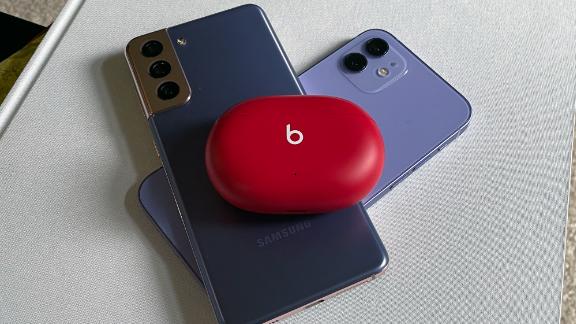
Jacob Krol/CNN
The appeal of the H1 or W1 chip was instant pairing with Apple devices like iPhones — and then automatic syncing across the Apple ecosystem. It’s the same tech that powers the “it just works” ethos that makes AirPods a popular choice. And now Beats’ custom chip takes fast pairing to a new level.
Yes, it will still fast pair with iOS devices — but the feature also extends to Android phones. It’s pretty impressive and is similar to the Android fast pair experience we saw on Pixel Buds and Sony’s WF-1000XM4. Beats Studio Buds are the first pair of earbuds (or headphones) that can fast pair with Apple and Android alike.
Flip the pocketable case’s lid open and it will start broadcasting a signal. Hold it close to your iPhone or Android and you’ll see a flash screen appear that asks if you’d like to pair. It’s that simple — after that, you are ready to rock out. On an iOS device, you’ll find controls for ANC built into the volume adjuster. On Android, there’s the Beats app available for download. You can, of course, also use a click button on the earbuds themselves for adjustments.
One oddity is that you’ll need Android 6.0 or newer for fast pairing and Android 7.0 for the Beats app. Considering Android 11 is the current official release (with Android 12 arriving in the fall), we don’t expect compatibility to be an issue. Apple users will need the latest version of iOS (iOS 14.6) for full compatibility.
Better yet, we didn’t experience any connection issues in our testing. We tested Studio Buds with a range of devices, including the iPhone 12 Pro, Pixel 4a 5G, Galaxy S21 Ultra, iPad Pro, MacBook Pro, Apple TV and Fire HD 10, among others.
And since we’re on the subject of setup, the Studio Buds arrive in a pretty simple box. No flashy designs of Beats past featured here — in the box, you’ll get a USB-C to USB-C cable for charging along with two extra ear tip sizes: small and large in the box with medium installed on Studio Buds by default. You’ll also find a free trial for at least three months of Apple Music in the box, which is a nice added value.
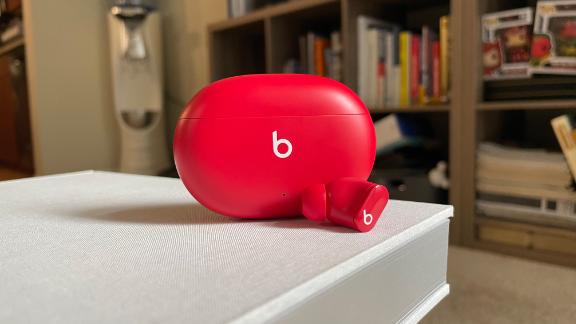
Jacob Krol/CNN
The most accurate way to describe the Studio Buds is tiny and comfortable. Beats’ previous true wireless option is the Powerbeats Pro — earbuds complete with ear hooks that offer a sturdier build that isn’t pocketable. The Studio Buds slim things down with a design more reminiscent of widely popular earbuds like the Galaxy Buds Plus, Jabra Elite 75t and Echo Buds.
Where things get interesting is what they look like and how you place them in your ear, as you almost have to rotate them to lock them into place. The earbuds themselves have a rectangular wedge that sticks out of your ear, and it’s a slight slant with a glossy finish that features a “b” logo. Thanks to this design, you can easily grab hold of Studio Buds, both to take out of the case or your ears. The main hull of Studio Buds fits in our ear nicely, with the ear tip portion extending into the ear canal.
Beats is still not offering a software feature to help you see if the fit is correct. AirPods Pro, Galaxy Buds, Echo Buds and even the Sony WF-1000XM4 all offer this, but Beats leaves it up to you. We’d recommend trying all the included sizes until you find the one that fits right — kind of a modern-day Goldilocks journey.
The ear tips are color-matched to the color of Studio Buds. The ear tips themselves, though, aren’t color-coded for size, a new approach that we’ve seen from Sony and Amazon recently. Studio Buds come in a fiery red, black or white. We’ve been testing the red, and it’s an excellent way to show some personality.
Studio Buds are extremely comfortable in our ears and didn’t apply an extreme amount of pressure in our ear canal. They are smaller than the diameter of a quarter and each weigh in at 5.1 grams. We could comfortably wear these throughout the working day, in stationary positions and while walking around. We didn’t encounter any issues with them staying in our ears. You can also use these for workouts or even in rainy weather conditions. These earbuds feature an IPX4 resistance rating.
Let’s be real: Powerbeats Pro had a massive case. If you could fit it in your pants pocket, it made quite the bulge and just frankly wasn’t pocket-friendly. They had long battery life, so many times we’d opt to not bring the charging case along. Studio Buds have a much more compact case that’s only slightly larger than that of the AirPods Pro. It is bigger than Echo Buds or the super-compact Sony WF-1000XM4. Studio Buds magnetically lock into their respective charging slots, and there’s an LED indicator (along with a “b” logo) on the front. The bottom of the case features a USB-C port, which you’ll need to use for charging. There’s no wireless charging here, though, and that’s disappointing.
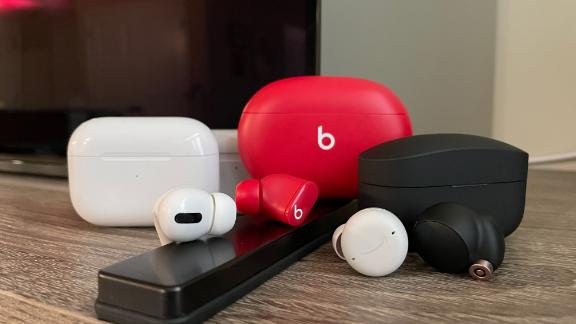
Jacob Krol/CNN
The Studio Buds deliver a modern-day interpretation of the signature Beats sound, which once emphasized bass but has become more balanced in recent years. The result is an energetic mix with a wide soundstage that works across every genre we threw at them.
In Olivia Rodrigo’s “Good 4 U,” the opening bass synth is robust, and Studio Buds don’t end up crackling between the low and even lower audio wave. Furthermore, when vocals get overlaid with a snare drum and a mix of electronic sounds, Studio Buds let each instrument come through with a big wall-of-sound effect. Nothing gets lost in the mix, and the sound is really crisp.
That’s a pop-punk track, but what about classic rock? In “Last to Die” by Bruce Springsteen, the opening violins and guitars come through with no loss of clarity, and Studio Buds deliver a strong clash when the remaining instruments (guitar, drums, saxophone, piano and vocals) come together. It’s also a good example of how a stereo mix on Studio Buds can still deliver proper echo within a track without resulting in a messy mix.
Studio Buds can still push out a lot of sound for a relatively small earbud. And while the oomph or forcefulness is a bit less than Powerbeats Pro, it’s a similar overall mix. In our conversation with Todd Parker, head of acoustics at Beats, he shared with us that there’s an 8.2-millimeter speaker deck inside Studio Buds, which is about half the size of Powerbeats Pro. The team set out on a goal to still produce a sound that is just as good as any other product that Beats has produced. Given the smaller size of Studio Buds, Beats also opted for a vent that helps to reduce pressure in your ear.
“We’re always striving for a balanced tonality. I’m a believer that music sounds best on a playback device that was made during that time,” says Parker.
“It needs to be energetic. You want to put those headphones on, you’re putting them on for whatever that reason is, but you want the emotion and the energy of that music when you’re looking forward to be able to transcend through the headphone,” Parker continues. Beats are known for a forceful wall-of-sound approach that we’ve called powerful in the past.
We especially liked Powerbeats Pro for workouts, as they can pump you up within a moment, and Studio Buds are following nicely in that legacy based on our testing. Our main qualm here is that there’s no way to customize the EQ or mix. Echo Buds offer this and Sony’s WF-1000XM4 take it further with precise controls on a digital soundboard.
ANC on Studio Buds is pretty strong, especially when it comes to blocking out loud bangs, traffic noise and an HVAC or AC blower. In our testing, with music playing, the Buds can reduce those sounds to relatively low hums. However, these can’t fully block them out unless you raise the music. For the company’s first ANC approach with a custom chip, Beats did an admirable job, but these don’t achieve the levels of AirPods Pro or Galaxy Buds Pro. They’re closer to the Echo Buds, but those do a bit better.
The track record gets better with Transparency, a mode that allows some of the environmental noise in. We use it to help get our bearings when listening to music outside or when we want some ambient noise in the mix. It’s quite good on Studio Buds, reminding us of the performance on Solo Pro.
For $150, it’s a good experience but not a stellar one. We’re hoping Beats might be able to issue some updates to improve ANC, as these do feature a five-microphone array and the chip for blocking out noise.
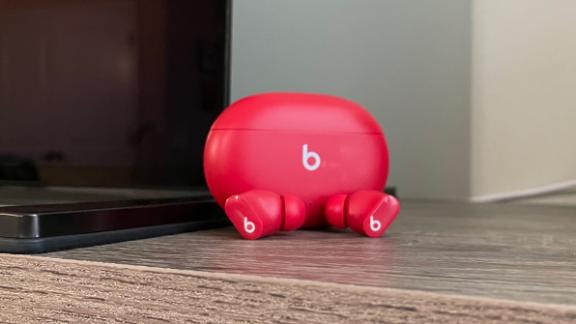
Jacob Krol/CNN
If you’re using Apple Music on an Apple device, Studio Buds can take advantage of Spatial Audio and Dolby Atmos tracks. As Parker describes it, “You’re taking an out-of-the-head experience and trying to put it in your head. By definition of physics, you’re tricking the brain to think that you’ve more dimension when it’s really coming from left, right.” With mixing for Spatial Audio it’s all about placing the elements of track to create an experience that has more depth to it.
With a track like “Down on the Corner” by Creedence Clearwater Revival, the mixing gives instruments more separation. The shaker is spotlighted on the left side, while the drums and bass tones sit on the right and center. It’s just a more immersive experience that in our view makes music a bit more enjoyable at times. It’s not just a classic left and right experience. StudioBuds will not support head tracking since they don’t have the hardware on board, but Spatial Audio doesn’t support this on Apple Music until the fall.
That’s just one example; Apple Music has done a good job curating a few playlists that take advantage of this feature. Some other songs that we really noticed more spatially with are “The Man” by Taylor Swift (listen for the echo of bass and main vocals in center), “Swan Lake Suite” (for exceptional placement of sound all around you) and “We’re an American Band” by Grand Funk Railroad (for a wide range of instruments scattered in space). We’ll be diving more into Spatial Audio, Dolby Atmos and Lossless tracks within Apple Music soon.
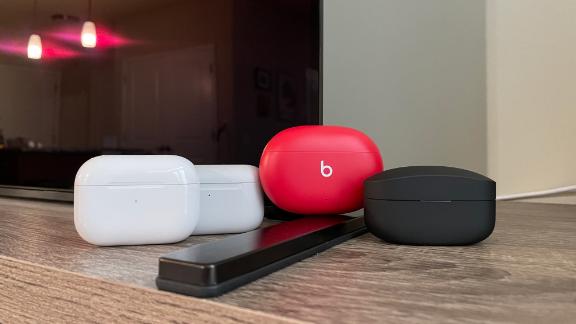
Jacob Krol/CNN
Call quality with Studio Buds is an especially important factor in the year 2021, as many of us are still in that work-from-home or school-from-home lifestyle. Studio Buds use beam-forming microphones that focus on your voice and listen for environmental noises like wind to block out. These do a formidable job on the first part, but it leads to some echoes being mixed in.
Friends and colleagues alike noted that at times there was a slight echo to our voice, as if we dialed in from a large warehouse where our voice didn’t come across extra crispy. You can listen for yourself, and we did experience this when connected to a bevy of devices. It wasn’t limited to just one OS or piece of hardware. One good point on voice pickup would be that we didn’t have any connection or vocal dropouts on calls. That goes for traditional cellular as well as VoIP services like Zoom, Slack, Teams and Webex.
These earbuds succeed in the runtime department. With no ANC or Transparency mode engaged we got eight hours and 30 minutes of playback with the volume set to 50%. That’s a full 30 minutes over the promised eight hours from Beats. With ANC engaged, that did drop by over three hours, falling to five hours. That’s not a disappointment, though, as it’s the promised runtime with ANC or Transparency engaged. With either route, the case provides an additional two full charges for Studio Buds when at 100%. Placing the earbuds in the case for five minutes does deliver around 45 minutes to an hour of playback. It will depend on modes engaged and your listening volumes.
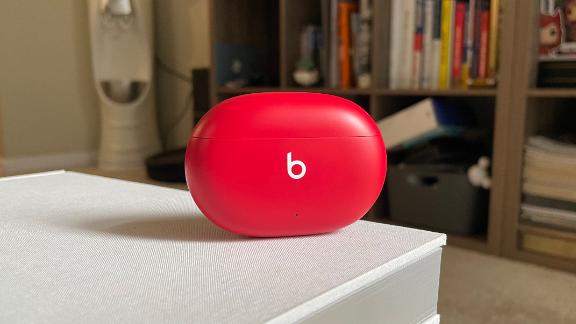
Jacob Krol/CNN
The Studio Buds deliver a lot to like within a superbly comfortable build that strikes a balance in terms of compatibility and features. At $149.99 there’s quite a bit of value here.
A robust energetic audio mix pairs with long battery life, fast pairing for Android or iOS and a portable design. You also get three colors, which is a step beyond AirPods or AirPods Pro. The star here, though, is really a comfortable design that lets you forget about the buds themselves and focus on the music.
Studio Buds fit more comfortably and sound better than AirPods or Galaxy Buds. They also offer fast pairing with Android or iOS while mixing in other features that these don’t offer (ANC, Transparency and support for Spatial Audio). It’s worth paying less (with AirPods at $159.99) or a bit more (with Galaxy Buds at $129.99) for a well-rounded experience. Those who want strong ANC will need to look at AirPods Pro, Galaxy Buds Pro, Jabra Elite 75t or Sony WF-100XM4. These earbuds are also great for workouts — strong sound and a comfortable design make these excel here.
Beats Studio Buds are available for preorder now at $149.99 and will ship on June 24.
[ad_2]
Source link









